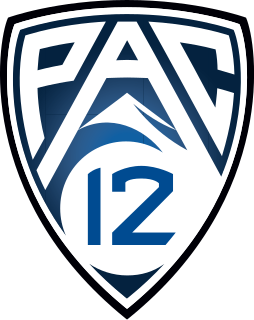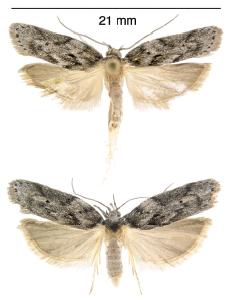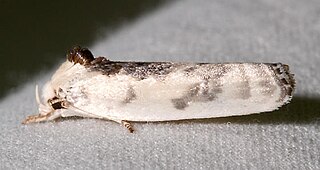
Utah is a doubly landlocked state in the western United States. It is bordered by Colorado to the east, Wyoming to the northeast, Idaho to the north, Arizona to the south, and Nevada to the west. It also touches a corner of New Mexico in the southeast. Of the fifty U.S. states, Utah is the 13th-largest by area, and with a population over three million, the 30th-most-populous and 11th-least-densely populated. Urban development is mostly concentrated in two areas: the Wasatch Front in the north-central part of the state, which is home to roughly two-thirds of the population, and Washington County in the south, with more than 170,000 residents. Most of the western half of Utah lies in the Great Basin.

The Pac-12 Conference is a collegiate athletic conference that operates in the Western United States, participating in 24 sports at the NCAA Division I level. Its football teams compete in the Football Bowl Subdivision, the higher of two tiers of NCAA Division I football competition.

The Western Athletic Conference (WAC) is an American collegiate athletic conference formed on July 27, 1962 and affiliated with the National Collegiate Athletic Association (NCAA) Division I. The WAC covers a broad expanse of the western United States, with member institutions located in Arizona, California, New Mexico, Utah and Washington, along with the "non-western" states of Missouri and Illinois as well as Texas.

The Southwestern United States, also known as the American Southwest, Desert Southwest, or simply the Southwest, is the informal name for a region of the western United States. Definitions of the region's boundaries vary a great deal and have never been standardized, though many boundaries have been proposed. For example, one definition includes the stretch from the Mojave Desert in California to Carlsbad, New Mexico, and from the Mexico–United States border to the southern areas of Colorado, Utah, and Nevada. The largest metropolitan areas are centered around Phoenix, Las Vegas, Tucson, Albuquerque, and El Paso. Those five metropolitan areas have an estimated total population of more than 9.6 million as of 2017, with nearly 60 percent of them living in the two Arizona cities—Phoenix and Tucson.

The Colorado River is one of the principal rivers in the Southwestern United States and northern Mexico. The 1,450-mile-long (2,330 km) river drains an expansive, arid watershed that encompasses parts of seven U.S. states and two Mexican states. Starting in the central Rocky Mountains of Colorado, the river flows generally southwest across the Colorado Plateau and through the Grand Canyon before reaching Lake Mead on the Arizona–Nevada border, where it turns south toward the international border. After entering Mexico, the Colorado approaches the mostly dry Colorado River Delta at the tip of the Gulf of California between Baja California and Sonora.

The State of Deseret was a provisional state of the United States, proposed in 1849 by settlers from The Church of Jesus Christ of Latter-day Saints in Salt Lake City. The provisional state existed for slightly over two years and was never recognized by the United States government. The name derives from the word for "honeybee" in the Book of Mormon.
U.S. Route 491 (US 491) is a north–south U.S. Highway serving the Four Corners region of the United States. One of the newest designations in the U.S. Highway System, it was created in 2003 as a renumbering of U.S. Route 666 (US 666). With the 666 designation, this road was nicknamed the "Devil's Highway" because of the significance of the number 666 to many Christian denominations, which believe it to be the Number of the Beast. This Satanic connotation, combined with a high fatality rate along the New Mexico portion, convinced some people the highway was cursed. The problem was compounded by persistent sign theft. These factors led to two efforts to renumber the highway, first by officials in Arizona, later in New Mexico. There have been safety improvement projects in recent years, and fatality rates have subsequently decreased.
Save Ferris is an American ska punk band formed circa 1995 in Orange County, California, United States. Their name is a reference to the 1986 film Ferris Bueller's Day Off. In 1995, the band began to perform underground venues in Southern California. In 1996, the band won a Grammy showcase award for best unsigned band and a contract with Epic Records. Their album It Means Everything from 1997 was their first full-length album. By 1999, the band moved from ska-pop into pop-punk. After a hiatus, in 2017, Save Ferris released the Checkered Past EP.

Rio Tinto Stadium is an American soccer-specific stadium in Sandy, Utah, that serves as home stadium for Major League Soccer club Real Salt Lake and National Women's Soccer League club Utah Royals FC. The stadium opened on October 9, 2008, and seats 20,213 for soccer, but can be expanded to over 25,000 for concerts.

The UTEP Miners football program represents University of Texas at El Paso (UTEP) in the sport of American football. The Miners compete in the Football Bowl Subdivision (FBS) of the National Collegiate Athletic Association (NCAA) and the West Division of Conference USA (CUSA). They are currently coached by Dana Dimel. UTEP has produced a Border Conference championship team in 1956 and a Western Athletic Conference championship team in 2000, along with 14 postseason bowl appearances. The Miners play their home games at the Sun Bowl which has a seating capacity of 51,500.

The Paradox Basin is an asymmetric foreland basin located mostly in southeast Utah and southwest Colorado, but extending into northeast Arizona and northwest New Mexico. The basin is a large elongate northwest to southeast oriented depression formed during the late Paleozoic Era. The basin is bordered on the east by the tectonically uplifted Uncompahgre Plateau, on the northwest by the San Rafael Swell and on the west by the Circle Cliffs Uplift.

Benjamin Gilbert Ferris was a Secretary to the Territorial Government of Utah, a lawyer, a district attorney and leader in Ithaca (town), New York.

The Mountain West Conference Men's Basketball Player of the Year is a basketball award given to the Mountain West Conference's most outstanding player. The award was first given following the 1999–00 season—the first year of the conference's existence. As of 2015, no player has received the award multiple times. Two winners of the conference award were consensus national Players of the Year—Andrew Bogut of the University of Utah in 2004–05 and Jimmer Fredette of Brigham Young University (BYU) in 2010–11.

The 2009 Western Athletic Conference (WAC) football season was an NCAA football season played from September 3, 2009, to January 4, 2010. The Western Athletic Conference consists of 9 members: Boise State, Fresno State, Hawai'i, Idaho, Louisiana Tech, Nevada, New Mexico State, San Jose State, and Utah State. Boise State won the 2009 WAC title going 13–0, 8–0 in conference and were invited to play in the Fiesta Bowl, in which they defeated previously unbeaten TCU. Nevada, Fresno State, and Idaho also played in bowl games, the Hawaiʻi Bowl, New Mexico Bowl, and Humanitarian Bowl, respectively. Nevada lost to SMU and Fresno State lost to Wyoming, while Idaho beat Bowling Green.

Antaeotricha arizonensis is a moth of the family Depressariidae. It is found in the United States in the mountain ranges in south-eastern Arizona and south-western New Mexico.

Antaeotricha is a genus of moths. It is the largest genus in the subfamily Stenomatinae, numbering over 400 species in the Western Hemisphere.

The 2011 Western Athletic Conference football season is a college football season for the Western Athletic Conference. The 2011 season consisted of eight members: Fresno State, Hawaiʻi, Idaho, Louisiana Tech, Nevada, New Mexico State, San Jose State, and Utah State.

Solar power in Utah has the potential to provide all of the electricity used in the United States. Utah is one of the seven US states with the best potential for solar power, along with California, Nevada, Arizona, New Mexico, Colorado, and Texas. Utah allows net metering for residential systems up to 25 kW and up to 2 MW for non-residential users. Utah's renewable portfolio standard can best be described as a goal and calls for obtaining 20% of electricity from renewable sources by 2025 – if it is cost effective.

Maverik Stadium, also known as Merlin Olsen Field at Maverik Stadium, is an outdoor college football stadium in the western United States, on the campus of Utah State University in Logan, Utah. The home field of the Utah State Aggies of the Mountain West Conference, it opened 52 years ago in 1968 as "Romney Stadium" and currently has a seating capacity of 25,100. Its field has a traditional north-south alignment, and sits at an elevation of 4,710 feet (1,435 m) above sea level. The playing surface was natural grass through 2003, and is currently AstroTurf GameDay Grass.














